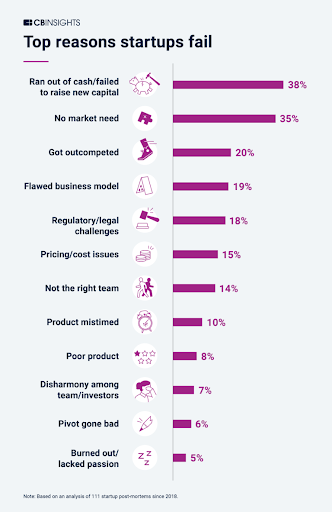Today we are taking you on a detailed journey of how to create a Minimum Viable Product (MVP) in Website form. Now, why would anyone need an MVP website development? Before we answer that question, read this.
CB Insights said 70% of startup techs fail, the University of Toronto said that 80% of new retail products fail, and Clayton Christensen said that 95% of all new products fail. If you want to launch something new in the market, you need to lower the chances of failure, a small-scale product, a stepping stone, a place where you can test the market need before investing, before the loss, or before the success.
It is where an MVP comes in. Launch a product with the minimum required features to test against market needs. It saves you time and money before you somersault into full-scale development.
What is an MVP?
An MVP is an early, basic version of any product with fundamental features just enough for the initial end-user to operate it. We have talked about it in detail before.
It is launched not to attract users and solve problems but to analyze the market need for the product and receive feedback from its users.
This feedback is the data that helps to add more and more features to the product based on the customer need, hence building over the MVP and expanding the product or app over time.
Why use an MVP?
As the definition of MVP depicts,
- It gains productive user feedback.
Of course, building the product around user needs is an excellent option. - Not to mention, MVPs are simpler versions of the big-scale developments, hence easier to develop and push out.
- Simpler versions mean less time and money consumed in developing it.
- Minimal resources are required to test an MVP compared to full-scale development. It also decreases the loss risks at the other end.
- The feedback an MVP receives comes from their targeted users. Hence, it can add a pointed development and direction to the product. It increases the chances of users liking the updates as well.
- The development of the product gets paced out, allowing breathing room at the developer end for things like testing, investing, engineering, and more.
- An MVP can not only be scaled into a single product but, at times, can also be scaled into multiple products based on viability.
- There is no certification or protocol to pass when launching your MVP over the web.
- You don’t have to worry about application store appropriation and the market split between iOS and Android.

Let’s look a little deeper,
Build an MVP in Web Development
Before you start building an MVP, learn where your audience is at? Mobile or Web? If your target is mobile-first, launch an MVP app first, but if your audience has regular web usage as well, we suggest you begin building your MVP in web development.
Two reasons:
Instead of aspiring for two app store launches and their certification checks, an MVP website development project will be comparatively simpler to tackle.
Step 1 : Market Need Research
The insights from CB Insight about failing startups outline the reasons for their failure. 35% of them fail because they have no real market need.

Do not make your product value or solution your starting point; start with market research. What are the real challenges or needs in the market, in the world, and which challenges or needs will your product solve or meet?
Why has there not been another solution or answer like your product? If there is, how is yours better? Surveys and experts are your real friends. Be prepared because investors ask the same question.
Step 2: Narrow Down The Features
Try not to take on all the problem solutions at once. Narrow down on solving one problem, meeting one demand, and filling one gap.
It will help you zero in on the essential features of the product. These will be your basic features in the MVP. These features, though small in number, must provide value that will promote your MVP in the web development stage to your users in the initial step.
It also helps your user focus on minimum features and usage, which derives maximum advantage during the feedback cycle.
Step 3: MVP Flow
It’s time to start brainstorming design options for your MVP website development. The design has to be user-friendly.
Define your goals. What do you want from the user when they come to the website? Conversion? Purchase? Define your goal and build the interface around it.
Are the features present enough for them to achieve what they want out of your product? Incorporate the essential components in an easy-to-navigate style. The business aspect is fulfilled by visualizing the user perspective.
Above all, make the site, first and foremost, user-friendly throughout it all.
Step 4: Success Metrics
Now that you have a product with good market value and a user base consuming your web MVP, you need to take a step further and consider what’s next.
Your product can’t go on to remain an MVP forever. Updating and upgrading are essential to staying relevant in the long run and increasing your product value in the market.
Success metrics you set for your initial stage product derive your MVP’s meaning in website development. These KPIs will derive the parts of your website that will need growth in the future. These will help you scale the businesses and are the ones worth spending time and money on.

MVP meaning in Website Development
Using a Minimum Viable Product for a Website Development project stands out differently than being a usable product with minimum features.
Functional, not minimal
Do not focus on the word itself but the product's functionality. By using the term minimum, the product in no way tries to tone down the number of features in the initial website launch. It is not zeroing in from an expanded version but more like expanding out from scratch upto the minimal requirements.
It is pretty different from mobile development MVPs as they need to meet specific criteria and must-have features that will deem it fit for minimum mobile usage, which is not the case with MVP web-developed projects.
Viable is Not for Everyone
We have talked about functionality and usability, but all this seems null without bringing in your target audience. Remember, no product is for everyone.
When you begin, niche down on the specific kind of user you want and make the website product functional and viable for that particular audience.
Keep track of your KPIs. Once the viability is proven, you have more room to breathe and some in-demand features to expand upon.
Conclusion
Big dreams need strong foundations. A Minimum Viable Product is the starting point of the large-scale venture you want to undertake.
Follow the steps above to create a valuable MVP for your product. As for success and failure, it depends on more than one factor. If your MVP rises with the market need, the scale at a steady pace, and if you see a decline, you gain invaluable experience in MVP launching.
Use this experience to catapult yourself with a brand new start.


